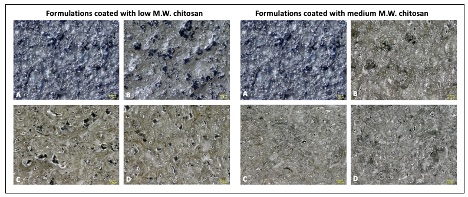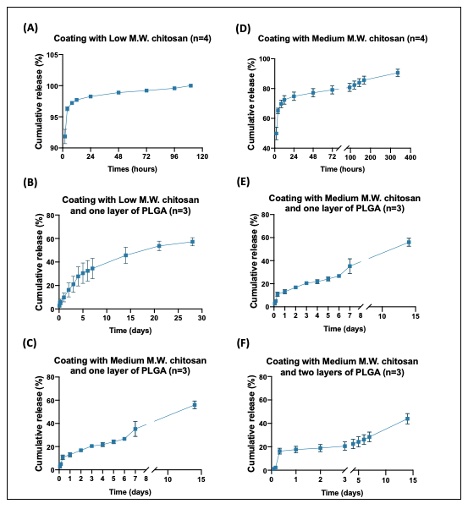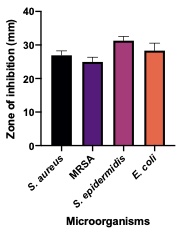Formulation and Delivery - Chemical
Category: Poster Abstract
(T0930-11-70) Amikacin Coated 3D-Printed Metal Devices for Prevention of Postsurgical Infections (PSIs)
Tuesday, October 24, 2023
9:30 AM - 10:30 AM ET
- CZ
Chu Zhang, MS (she/her/hers)
Auburn University
Auburn, Alabama, United States - CZ
Chu Zhang, MS (she/her/hers)
Auburn University
Auburn, Alabama, United States 
Ishwor Poudel, MS (he/him/his)
PhD Candidate
Auburn University
Auburn, Alabama, United States- MA
Manjusha Annaji, MS
PhD student
Auburn University
auburn, Alabama, United States - PP
Peter Panizzi, Ph.D. (he/him/his)
Auburn University
Auburn, Alabama, United States - NS
Nima Shamsaei, Ph.D. (he/him/his)
Auburn University
Auburn, Alabama, United States - JR
Jayachandra Ramapuram, Ph.D.
Auburn University
auburn, Alabama, United States - RA
Robert Arnold, Ph.D.
Auburn University
Auburn, Alabama, United States
Presenting Author(s)
Main Author(s)
Co-Author(s)
Purpose: Personalized three-dimensional (3D)-printed metallic implant delivery systems are being explored to repair bone fractures. 3D printing technology, also referred to as additive manufacturing, fabricates a 3D physical structure by successive addition of materials using a computer-aided design (CAD) model [1]. 3D printing enables the customization of medical implants that respond to each patient’s specific need, making it potentially more effective and of greater quality than mass-produced devices [1, 2]. However, challenges associated with postsurgical infections caused by bacterial adhesion and biofilm formation on the surface of the implants remain a clinical challenge [3]. Due to the potential for multidrug-resistant infections, local antibiotic therapies are being explored to minimize the risk of implant-related infections. Amikacin (AMK) is clinically approved and becoming the most widely used drug for treating serious aminoglycoside-resistant infections. Amikacin has a broad spectrum of activity compared to other aminoglycosides, and it offers better effectiveness against microorganisms. Both poly lactic-co-glycolic acid (PLGA) and chitosan are biodegradable and biocompatible polymers used clinically as drug delivery matrices. Multiple possibilities of adjusting drug release without considering other surgical complications of their residence at the site of action can be provided by incorporating such polymers on metal implants. The objective of this research was to develop an effective amikacin delivery coating on stainless steel implants to inhibit the growth of bacterial biofilm and mitigate the risk of infections.
Methods: 3D-printed metal implants were fabricated from 316L stainless steel (316L SS) using Renishaw AM 250 3D-printer, a selective laser melting additive manufacturing machine based on the laser beam powder bed fusion system. Low and medium-molecular-weight chitosan was prepared in 1% acetic acid. Then amikacin powder was dissolved in two different molecular weight chitosan solutions. Amikacin-chitosan coating was prepared on a metal implant surface via syringe-extrusion 3D printing and allowed to dry, 30 ℃ overnight. PLGA, 500 μL of 50 mg/mL, was deposited on the amikacin-chitosan coating layer using the drop-casting technique, followed by the evaporation of the organic solvent. Surface morphology and roughness of the coating layer on the metal implant surface were characterized microscopically. The in vitro drug release was carried out in release media, PBS (pH 7.4) at 37 ℃ within one month. The whole media was removed and replaced with fresh release media at each sampling point and analyzed by high-pressure liquid chromatography (HPLC) with visible absorbance (UV detector). A modified HPLC method [4] was developed and validated to quantify the amount of drug on the surface of each implant. The cumulative release percentage was plotted as a function of time. All data were represented as mean ± standard error of the mean (n=3). The metal implants were immersed in digestion media (1% acetic acid: [PBS] pH 7.4, 50:50 v/v) overnight to detect the residual amounts of the drug present in the implants. Then, four different bacterial strains (S. aureus, MRSA, S. epidermidis, E.coli ) were selected to determine the minimum inhibitory concentrations (MICs) with the amikacin test strip. And amikacin-polymer coated implants were applied to determine the zone of inhibition to determine time-course and degree of antimicrobial efficacy.
Results: Drug content uniformity was determined by HPLC. Weight uniformity was calculated by the difference before and after drug and polymer deposition on the implant surface. The weight uniformity of the implants after drying was 18.13 ± 0.69 and 12.06 ± 0.64 mg, and the drug content uniformity was within 5% of the variance for both low and medium molecular weight chitosan formulations. The surface morphology of amikacin-chitosan-PLGA coated implants (Figure 1) showed a thick deposition of drug and polymer on the implant surface. The image of the amikacin-chitosan coat showed tight adhesion of the polymeric layer to the implant surface compared to the control group. Figure 2 indicated the in vitro release profile of implants with different molecular weights of chitosan in the amikacin-chitosan coating. Both low and medium molecular weight chitosan coating batches showed a burst release during the initial 24 hours. Low molecular weight chitosan coated with PLGA layers batch showed an ideal sustained release profile within one month. As shown in Figure 3, implants coated with polymers and amikacin indicated antibacterial activity against various microorganisms, especially MRSA, that’s become resistant to many of the antibiotics used to treat ordinary staph infections.
Conclusion: In this study, formulation coating approaches and appropriate biodegradable polymers for coating were optimized. Release profiles of amikacin with variable polymers and drug loading percentages were carried out within one month. Chitosan with varying molecular weights presented different release profiles. Low molecular weight chitosan coated with PLGA layers batches showed an ideal sustained release profile. The microbial study indicated that amikacin-polymer formulations had efficacy against various bacterial strains. The significance of additive manufacturing in the fabrication of metal implants coated with amikacin-polymer was established. 3D printing enables producing multiple versions of a drug for variant populations in short-run batches.
References: 1. Shahrubudin, N., T.C. Lee, and R. Ramlan, An Overview on 3D Printing Technology: Technological, Materials, and Applications. Procedia Manufacturing, 2019. 35: p. 1286-1296.
2. Singhvi, G.P.S.G., V.; Chellappan, D. K.; Gupta, G.; Dua, K., 3D-printing: an emerging and a revolutionary technology in pharmaceuticals. Panminerva Medica, 2018. 60(4): p. 170-173.
3. Valliammai, A., et al., Polymeric antibiofilm coating comprising synergistic combination of citral and thymol prevents methicillin-resistant Staphylococcus aureus biofilm formation on titanium. Mater Sci Eng C Mater Biol Appl, 2021. 121: p. 111863.
4. Nicoli, S. and P. Santi, Assay of amikacin in the skin by high-performance liquid chromatography. J Pharm Biomed Anal, 2006. 41(3): p. 994-7.
 Figure 1. Surface morphology of amikacin and low/medium molecular weight chitosan (20 mg blend) coated on 2.25 cm2 of the metal implant surface. (A) Control. (B) Implants coated with low/medium M.W. chitosan. (C) Implants coated with low/medium M.W. chitosan and one layer of PLGA. (D) Implants coated with low/medium M.W. chitosan and two layers of PLGA.
Figure 1. Surface morphology of amikacin and low/medium molecular weight chitosan (20 mg blend) coated on 2.25 cm2 of the metal implant surface. (A) Control. (B) Implants coated with low/medium M.W. chitosan. (C) Implants coated with low/medium M.W. chitosan and one layer of PLGA. (D) Implants coated with low/medium M.W. chitosan and two layers of PLGA. Figure 2. Drug release profile of implants with variable molecular weights of chitosan in AMK chitosan coating.
Figure 2. Drug release profile of implants with variable molecular weights of chitosan in AMK chitosan coating.  Figure 3. Antibacterial activity of implants coated with polymer and amikacin against various microorganisms.
Figure 3. Antibacterial activity of implants coated with polymer and amikacin against various microorganisms.